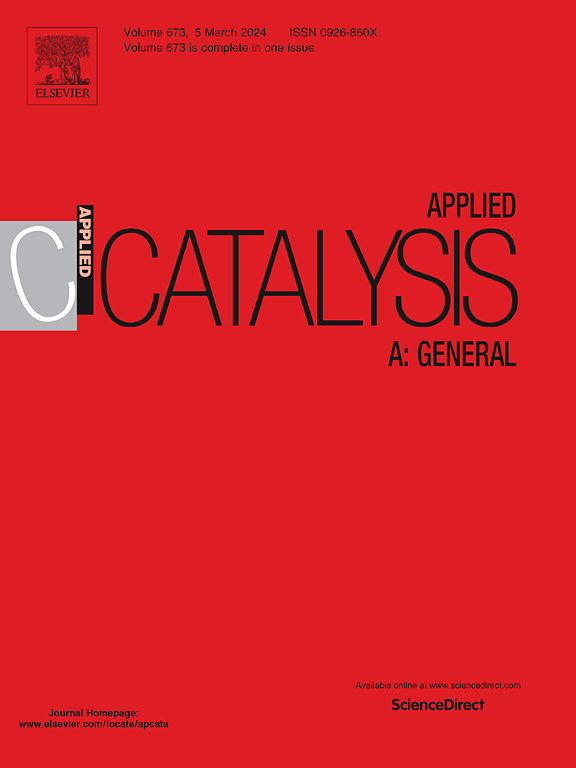γ-Al2O3-supported ruthenium carbonyls: Reactivity towards H2 and catalytic activity in CO2 methanation
IF 4.8
2区 化学
Q2 CHEMISTRY, PHYSICAL
引用次数: 0
Abstract
Ru3(CO)12 was used as a precursor to synthesize γ-Al2O3-supported Ru carbonyls via an impregnation method. The interaction between the precursor and the support was influenced by the degree of hydroxylation of the γ-Al2O3 surface, resulting in distinct Ru carbonyl species depending on the thermal treatment of the support. The reactivity of these supported Ru carbonyls toward H2 at increasing temperatures was investigated using infrared spectroscopy coupled with mass spectra of the gaseous products. The results indicate that Ru3(CO)12 adducts on Lewis acidic sites of γ-Al2O3 react with H2 to form various Ru carbonyl species. Some of these species generate methane via a stoichiometric reaction with H2. Samples containing supported Ru(CO)3 and Ru(CO)4 species were found to be active for CO₂ methanation at 140 °C. However, under reaction conditions, these initial carbonyls rapidly transformed into supported Ru dicarbonyl species, which remained stable during steady-state catalysis. To assess the possible role of supported Ru dicarbonyl species in the reaction, step changes in the reactor feed composition were performed while monitoring the infrared spectra of the samples and the mass spectra of the effluent gases. The data indicate coexisting pathways for CO2 methanation. The dominant route involves CO2 activation on the support, in which formate species act as intermediates in methane formation. Although the involvement of Ru dicarbonyl species in the catalysis cannot be ruled out, their presence may primarily result from a stoichiometric reaction between supported Ru and the CO2/H2 mixture.
γ- al2o3负载的钌羰基:对H2的反应性和CO2甲烷化的催化活性
以Ru3(CO)12为前驱体,通过浸渍法制备了γ- al2o3负载Ru羰基。前驱体与载体之间的相互作用受γ-Al2O3表面羟基化程度的影响,导致不同的Ru羰基种类取决于载体的热处理。利用红外光谱和气态产物的质谱,研究了负载Ru羰基在升温条件下对H2的反应性。结果表明,γ-Al2O3的Lewis酸位上的Ru3(CO)12加合物与H2反应生成多种Ru羰基。其中一些物种通过与H2的化学计量反应产生甲烷。负载Ru(CO)3和Ru(CO)4的样品在140°C时具有CO 2甲烷化活性。然而,在反应条件下,这些初始羰基迅速转化为负载的钌二羰基,在稳态催化过程中保持稳定。为了评估负载钌二羰基物质在反应中的可能作用,在监测样品的红外光谱和流出气体的质谱的同时,对反应器进料组成进行了步进变化。数据表明二氧化碳甲烷化的途径是共存的。主要的途径是二氧化碳在载体上的活化,甲酸类物质在甲烷形成过程中扮演中间体的角色。虽然不能排除Ru二羰基物质参与催化,但它们的存在可能主要是由负载Ru与CO2/H2混合物之间的化学计量反应引起的。
本文章由计算机程序翻译,如有差异,请以英文原文为准。
求助全文
约1分钟内获得全文
求助全文
来源期刊

Applied Catalysis A: General
化学-环境科学
CiteScore
9.00
自引率
5.50%
发文量
415
审稿时长
24 days
期刊介绍:
Applied Catalysis A: General publishes original papers on all aspects of catalysis of basic and practical interest to chemical scientists in both industrial and academic fields, with an emphasis onnew understanding of catalysts and catalytic reactions, new catalytic materials, new techniques, and new processes, especially those that have potential practical implications.
Papers that report results of a thorough study or optimization of systems or processes that are well understood, widely studied, or minor variations of known ones are discouraged. Authors should include statements in a separate section "Justification for Publication" of how the manuscript fits the scope of the journal in the cover letter to the editors. Submissions without such justification will be rejected without review.
 求助内容:
求助内容: 应助结果提醒方式:
应助结果提醒方式:


